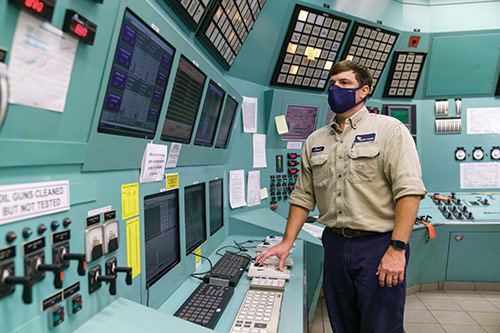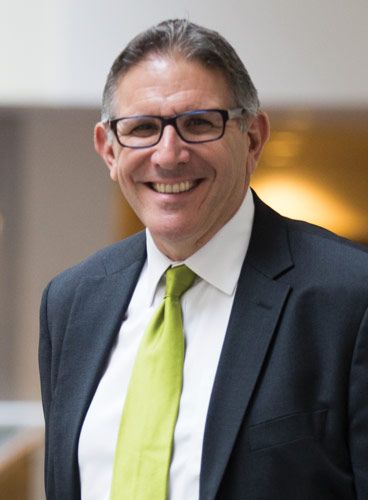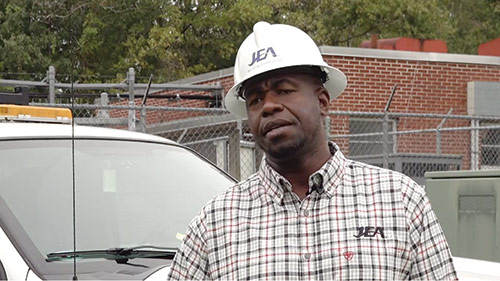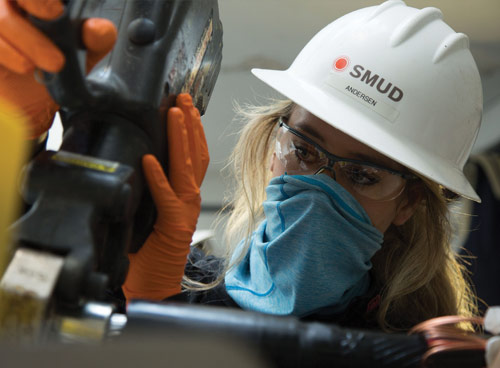Large Public Power Council
John Di Stasio is president of the Large Public Power Council.



Do you know what the Large Public Power Council is? While not as well-known as the American Public Power Association, of which all twenty-seven LPPC members are a part of too, LPPC enables the twenty-seven largest to collaborate on matters characteristic of their scale. They together employ fifty-two thousand people and own seventy-two thousand megawatts of generating capacity.
Washington has six LPPC utilities, Chelan County PUD No. 1, Clark Public Utilities, Grant PUD, Seattle City Light, Snohomish County PUD No. 1, and Tacoma Public Utilities, more than any other state. By the way, PUD stands for Public Utility District. California and Texas have three LPPC utilities apiece, Imperial Irrigation District, Los Angeles Department of Water and Power, and Sacramento Municipal Utility District in the Golden State and Austin Energy, CPS Energy, and Lower Colorado River Authority in the Lone Star State. Colorado, Florida, Nebraska, and New York have two apiece, Colorado Springs Utilities, Platte River Power Authority, Jacksonville Electric Authority, Orlando Utilities Commission, Nebraska Public Power District, Omaha Public Power District, Long Island Power Authority and New York Power Authority. The remaining LPPC utilities are American Municipal Power, ElectriCities of North Carolina, Grand River Dam Authority, MEAG Power, Puerto Rico Electric Power Authority, Salt River Project, and Santee Cooper.
The PUF team recently caught up with John Di Stasio, the president of LPPC. This time he talked with us about the remarkable accomplishments of those fifty-five thousand people, the workforce of the large public powers.
PUF's Steve Mitnick: What is LPPC and what is your role?
John Di Stasio: The Large Public Power Council represents twenty-seven of the largest public power systems in the U.S. We were formed in 1987 to collaborate around issues that uniquely affected larger systems, such as infrastructure, tax, and cybersecurity.
Collectively, our members serve thirty million electric consumers in twenty-one states and Puerto Rico. We're a significant voice in matters that affect larger municipal systems.
What's unique about our members is they're nonprofit, public power systems, so the way we raise money, build infrastructure, and collect revenues, is done differently compared to a traditional investor owned utility. That's why it's important for our voice to be considered in energy and environmental policy. The services we provide are the same, but how we raise money, and how we govern, is different.
PUF: Talk about how you became head of LPPC.
John Di Stasio: I spent thirty years in the utility industry and for the last six years of my career I was the CEO of SMUD in Sacramento. After retiring in 2014, my colleagues at LPPC called and said, we would like to establish a public policy office in Washington, D.C. to advance the interests of public power. I was asked to become the first president of LPPC, and I'm proud of that distinction, and all we've accomplished so far.
Five years later, I'm continuing in that role. I've become the face of the organization, the lobbyist, if you will. I guide the work of our professional lobbyists in Washington and regulatory staff. I perform a little bit of spokesperson, plus do air traffic control and guide the advocacy efforts.
PUF: You've managed to get the leaderships of the twenty-seven utilities talking a lot. What have you been up to?
John Di Stasio: The great thing about LPPC is how involved all our twenty-seven CEO members are. They are the board, and they play an active role in forming policy and guiding the direction of our organization.
When COVID-19 struck, we knew LPPC was uniquely positioned to act as a convener, so we provided our members with regular opportunities to come together and discuss what was going on throughout the country, as well as how industry and governments were responding.
We established regular calls for our member CEOs and senior utility executives to discuss best practices and critical issues like maintaining the health and safety of employees and fulfilling our mission to keep the lights on for millions across America. We had a lot to talk about �" everything from availability of personal protective equipment to testing regimes for employees to ensuring reliability of the grid.
Many of our discussions centered around how to keep our essential workers safe. Not all of our employees can work from home. There are many who have to remain on site or out in the field to ensure residential, businesses, and communities remain powered.
We talked about prioritizing the health and safety of essential crews, operators, and other employees critical to operating the system. What protocols are in place to isolate them or, in some instances, sequester them if necessary, to limit infection rates among our essential workers.
A lot of our members did wonderful work and innovated to meet this mission. NYPA had a sophisticated sequestration protocol that others benefited from. Salt River Project in Arizona established, through a partnership with Arizona State University, their own testing capabilities.
Some of things our members did were behind the scenes, but they were remarkable. They responded quickly, came up with great plans, and were diligent about how to execute them. Through the pandemic to date, we've had low infection rates relative to the communities we serve, and we've been able to continue providing essential services.
PUF: You're calling it Essential Utilities, Essential Workers, but it's the great workforces of companies that serve thirty million Americans. You decided, we need to get these stories and highlight and celebrate the amazing work they do every day that we don't hear about. Who came up with the idea and said, we need to do this?
John Di Stasio: LPPC's current Chair, Dan Sullivan, CEO of Grand River Dam Authority in Oklahoma, had written a piece earlier this year voicing his support for the silent heroes who make up our workforce.
He made the point that although reliable electricity is what underpins our way of life, particularly this year with many Americans working remotely, the men and women responsible for keeping our lights on are often overlooked.
With this in mind, and never losing site of the health and safety of our workforce, LPPC created our Essential Utilities, Essential Workers campaign to give thanks to the men and women of public power who have been so dedicated throughout the pandemic.
Utility workers are fantastic, and people are familiar with them when storms hit, and power needs to be restored. But a pandemic is something that none of us have navigated and yet we still need reliable power to keep our communities functioning.
We also wanted to raise awareness of how essential our workforce is. Our essential utility workers are the reason the lights turn on when we flip the switch, so it's critical they be considered indispensable. We want to say, despite the pandemic, we've maintained an essential service to society, in keeping the electricity flowing, and not having interruptions.
PUF: I've already seen the terrific stories you have in the video of Theodric Arline of JEA, in Jacksonville, and Libby Clark at Platte River Power Authority, and Jesse Brantley at Santee Cooper, in South Carolina. You had to think through, how to do this? Who to talk to? How did that evolve?
John Di Stasio: Our members were very enthusiastic when we brought this idea to them. We had great interest, so this campaign will continue over the coming months.
There are many wonderful stories and no one better to tell them than the people themselves, because they can showcase what we see every day. It's gratifying that people are interested to showcase their dedication to the public and they're great ambassadors when you see them on video.
PUF: It was moving, when you see video of Jesse Brantley from Santee Cooper, and his wife had a baby in the middle of the pandemic and he's in the control area. He has to wear a mask. Of course, he can't get sick. Then you had Theodric Arline from Jacksonville Electric Authority and there's a lot of construction. He and his colleagues want to keep the economy going. But they have to protect everybody from the virus.
John Di Stasio: That's right. The industry is built on having safety as a primary driver. When you add new safety requirements, they already have significant requirements doing electrical work, relative to observers being in proximity.
Now you add in personal protective equipment, testing protocols, and face masks. It creates an additional level of complexity, but they figure it out, show up, go to work, and it's fantastic.
PUF: Not only the safety ethic, but there is collaboration in the utilities industry. It's the concept of bringing all your companies together. You're probably constantly talking about, what can we do better?
John Di Stasio: That's a big part of what we do at LPPC. Part of it is the advocacy to make sure our interests are recognized and considered in public policy. The second part of it may be equally as big, and that's convening our members so they can share best practices and grow together.
We've done an endless amount of work on cyber to get everybody to a good level of maturity of their cyber programs. We've done a lot on the operations side. Beside the CEOs meeting virtually during COVID-19, we have weekly calls with the operations executives of all of the utilities, because they were learning from each other in terms of the safety practices and PPE. That convening and collaboration brings everybody to a strong level of understanding and response.
PUF: Is there an extra dimension because the economy has taken a hit and maybe that affects your organization? Your members are affiliated with municipalities, cities, and states. Does that put an extra challenge on members?
John Di Stasio: Thankfully, most of our members are managing through the financial realities of it. There are a couple of different things that are happening with slowdowns of economy or even closed businesses and unemployment.
There's either a loss in revenue and/or in significant cases, aging of receivables. But our members in many cases have either voluntarily suspended disconnects or all of them are doing some kind of payment arrangements to help customers make it through this time.
One of my concerns is that the pandemic is going to have an economic tail because we probably don't know if things are fully reopened, and who might ultimately fail to pay their electric bills. The assumption is that write offs will be a lagging circumstance.
Having said this though, most of our members started forecasting different potential scenarios. Most of them are seeing that the scenarios on the ground are not quite as severe as they had thought.
But there's another part of it beside the economic part. Many of the utilities operate in jurisdictions where they may not have the schools open. It's hard to bring employees, nonessential employees, back to work if there isn't childcare available.
That's a contributing factor. There are human factors, family factors that have to be considered in the decision making. It's the safety, and economics, but it's also the workforce and family issues that create some complexities we haven't had to deal with before.
PUF: With this Essential Utilities, Essential Workers, where's this going? What's next?
John Di Stasio: We're going to continue to roll this out and tell this story. The men and women of public power are dedicated to ensuring millions of Americans have access to reliable electricity, so it's important that their story is told.
Lead image: Heather Andersen, a journeyman cable splicer electrician, is a highly skilled essential worker at SMUD in Sacramento, California.
Category (Actual):
Department:
